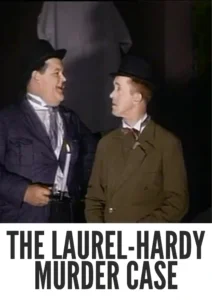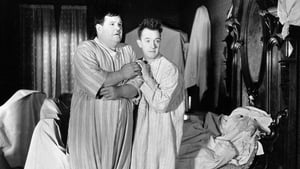Contact: info@alwanfilm.com
Video Sources 0 Views
Synopsis
Review: The Laurel-Hardy Murder Case 1930 Colorized – Exploring the Impact of Early Colorization

Introduction
In the rich tapestry of early 20th-century cinema, few comedic duos have left an indelible mark like Stan Laurel and Oliver Hardy. Their timeless slapstick humor and unforgettable antics have entertained generations. One of their classic films, “The Laurel-Hardy Murder Case” (1930), stands out not only for its comedy but also for its intriguing plot set against the backdrop of a murder mystery. Recently re-released in an early colorized version, this film offers a fresh perspective on the duo’s work. In this article, we explore the significance of the colorized version, its impact on the viewing experience, and its place in film history.
Check The Full Colorized Movies List
Check Our Colorized Movies Trailer Channel
Understanding The Laurel-Hardy Murder Case 1930 Colorized: Director, Cast, and Genre
“The Laurel-Hardy Murder Case,” directed by James Parrott, is a perfect blend of comedy and mystery, showcasing the comedic genius of Stan Laurel and Oliver Hardy. The film features the iconic duo as the main characters, who unwittingly find themselves embroiled in a murder mystery. Their performances, characterized by impeccable timing and physical comedy, have cemented their legacy in the annals of film history.
The genre of the film straddles comedy and mystery, a unique combination that adds depth to the narrative. The plot revolves around the duo’s misadventures as they investigate a murder at an eerie mansion, blending elements of suspense with their signature humor.
Exploring the World of The Laurel-Hardy Murder Case 1930 Colorized: Plot and Characters
“The Laurel-Hardy Murder Case” begins with Stan Laurel and Oliver Hardy receiving an invitation to the reading of a will, with the promise of a potential inheritance. They arrive at a spooky mansion, where they encounter a host of eccentric characters and a series of mysterious events. The plot thickens as they find themselves suspects in a murder case, leading to a series of comedic mishaps and misunderstandings.
The characters in the film are a colorful mix of suspects, each adding to the mystery and humor of the story. From the suspicious butler to the terrified maid, each character enhances the comedic tension, making the film a delightful romp through a classic whodunit scenario.
The Art of Film Colorization
Film colorization, the process of adding color to black and white footage, has long been a subject of debate within the cinematic community. Proponents argue that it revitalizes classic films for contemporary audiences, while detractors believe it compromises the original artistic vision and historical authenticity.
Colorization is a meticulous process that involves digitally adding color to each frame of the film. This requires careful attention to detail, ensuring that the colors chosen are appropriate for the period and setting of the film. When done correctly, it can enhance the viewing experience, making the film more accessible to modern audiences.
Early Colored Films: A Brief History
The history of film colorization dates back to the early 20th century, with techniques such as hand-painting and tinting being used to add color to black and white films. These early methods were labor-intensive and often produced inconsistent results. However, they paved the way for more sophisticated techniques, such as Technicolor, which revolutionized the film industry.
Technicolor, introduced in the 1920s, allowed for vibrant, lifelike colors and became the standard for color films for many years. The introduction of color films marked a significant milestone in cinematic history, offering filmmakers new creative possibilities and audiences a more immersive viewing experience.
The Laurel-Hardy Murder Case 1930 and Its Early Colored Version
The decision to release “The Laurel-Hardy Murder Case” in a colorized format is a bold move that invites viewers to experience the film in a new light. The early colorized version highlights the film’s atmospheric settings and brings a fresh perspective to the comedic and mysterious elements.
The colorized version enhances the film’s visual appeal, making the eerie mansion and its shadowy corners more vivid and engaging. The use of color adds depth to the characters and settings, highlighting details that may have been overlooked in the original black and white version. This reinterpretation offers both longtime fans and new viewers a unique way to appreciate the film.
The Debate Over Film Colorization
The colorization of classic films is a topic of ongoing debate within the film community. Purists argue that colorization alters the original artistic intent of the filmmakers, potentially compromising the film’s integrity. They believe that black and white films should be preserved in their original format to maintain historical authenticity.
On the other hand, proponents of colorization argue that it can make classic films more appealing to contemporary audiences, who may be less inclined to watch black and white films. They see colorization as a way to breathe new life into old films, making them more accessible and enjoyable for new generations.
Examining The Laurel-Hardy Murder Case 1930 as an Early Colored Film
Viewing “The Laurel-Hardy Murder Case” in its early colored version offers a unique perspective on the film. The colorization process enhances the film’s visual appeal, making the spooky mansion and its surroundings more immersive. The vibrant colors add a new dimension to the film’s comedic and mysterious elements, making it more engaging for modern audiences.
However, the colorized version also raises questions about the balance between artistic reinterpretation and historical authenticity. While the added color can enhance the viewing experience, it may also detract from the original aesthetic and charm of the black and white version. Ultimately, the decision to watch the colorized version or the original is a matter of personal preference, reflecting individual tastes and perspectives.
Influence and Legacy: The Laurel-Hardy Murder Case 1930 Colorized’s Impact on Cinema
“The Laurel-Hardy Murder Case” has had a lasting impact on cinema, influencing generations of comedians and filmmakers. The film showcases the comedic genius of Laurel and Hardy, whose timing, physical comedy, and chemistry have inspired countless performers. Their influence can be seen in the work of modern comedians and filmmakers who continue to draw inspiration from their timeless humor.
The film’s blend of comedy and mystery also paved the way for future genre hybrids, demonstrating the potential for combining different genres to create unique and engaging narratives. This innovative approach to storytelling has influenced a wide range of films and television shows, contributing to the evolution of comedic and mystery genres.
Director’s Cinematic Legacy: Beyond The Laurel-Hardy Murder Case 1930 Colorized
James Parrott, the director of “The Laurel-Hardy Murder Case,” played a significant role in shaping the comedic style of Laurel and Hardy. His collaboration with the duo resulted in some of their most memorable films, including “The Music Box” and “Helpmates.” Parrott’s ability to balance humor with narrative depth made him a key figure in the development of early comedy films.
Parrott’s legacy extends beyond his work with Laurel and Hardy, as he contributed to the evolution of comedy in cinema. His innovative use of visual gags, timing, and character dynamics influenced future generations of filmmakers, leaving an indelible mark on the industry.
Themes Explored in The Laurel-Hardy Murder Case 1930 Colorized
“The Laurel-Hardy Murder Case” explores themes of mystery, suspense, and humor, creating a unique blend of genres that keeps audiences entertained. The film’s plot revolves around the duo’s attempts to solve a murder mystery, leading to a series of comedic mishaps and misunderstandings.
The film also explores the theme of friendship, as Laurel and Hardy’s camaraderie and loyalty to each other are central to the story. Their unwavering support for each other, even in the face of danger and confusion, adds a heartwarming element to the film’s comedy.
Reception and Controversy Surrounding The Laurel-Hardy Murder Case 1930 Colorized
The release of “The Laurel-Hardy Murder Case” in its early colorized version has sparked both acclaim and controversy. Critics and audiences have praised the vibrant colors and enhanced visual appeal, while some purists have expressed concerns about the impact of colorization on the film’s original aesthetic.
Despite the controversy, the colorized version has introduced the film to a new generation of viewers, who may be more inclined to watch a colorized film than a black and white one. This renewed interest in the film highlights its enduring appeal and cultural significance.
Where to Watch The Laurel-Hardy Murder Case 1930 Colorized Online
For those eager to experience the timeless brilliance of “The Laurel-Hardy Murder Case,” the film is available on various streaming platforms. Whether in its original black and white format or the early colorized rendition, the film remains a must-watch for fans of classic comedy and mystery.
FAQs About The Laurel-Hardy Murder Case 1930 Colorized
Common queries surrounding “The Laurel-Hardy Murder Case” range from its historical accuracy to its thematic resonance in modern times. By addressing these frequently asked questions, viewers can gain a deeper understanding of the film’s enduring appeal and cultural significance.
Q: Is “The Laurel-Hardy Murder Case” historically accurate?
A: While the film is set in the 1930s and reflects some aspects of the period, it is primarily a work of fiction and does not aim for strict historical accuracy. The focus is on comedy and entertainment rather than historical fidelity.
Q: What makes “The Laurel-Hardy Murder Case” a classic?
A: The film’s blend of comedy and mystery, combined with the impeccable performances of Laurel and Hardy, make it a timeless classic. Its innovative narrative and memorable characters continue to entertain and inspire audiences.
Q: How does the colorized version compare to the original black and white film?
A: The colorized version offers a fresh perspective on the film, enhancing its visual appeal and making it more accessible to modern audiences. However, some viewers may prefer the original black and white version for its historical authenticity and artistic integrity.
Conclusion
In conclusion, “The Laurel-Hardy Murder Case” stands as a testament to the enduring brilliance of Stan Laurel and Oliver Hardy. The early colorized version offers a new way to experience this classic film, highlighting its timeless humor and intriguing mystery. Whether in color or black and white, the film’s charm and wit continue to captivate audiences, ensuring its place in the pantheon of cinematic history. As we reflect on the legacy of Laurel and Hardy, we are reminded of the power of laughter and the timeless appeal of their comedic genius.











